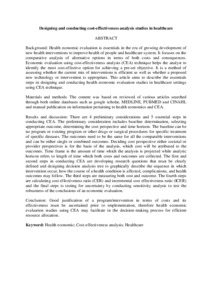Citation
Ismail, Noor Haslinda and Juni, Muhamad Hanafiah and Abdul Manaf, Rosliza and Ibrahim, Faisal
(2017)
Designing and conducting cost-effectiveness analysis studies in healthcare.
International Journal of Public Health and Clinical Sciences, 4 (5).
62 - 76.
ISSN 2289-7577
Abstract
Background: Health economic evaluation is essentials in the era of growing development of new health interventions to improve health of people and healthcare system. It focuses on the comparative analysis of alternative options in terms of both costs and consequences. Economic evaluation using cost-effectiveness analysis (CEA) technique helps the analyst to identify the most cost-effective option for achieving a pre-set objective. It is a method of assessing whether the current mix of interventions is efficient as well as whether a proposed new technology or intervention is appropriate. This article aims to describe the essentials steps in designing and conducting health economic evaluation studies in healthcare settings using CEA technique.
Materials and methods: The content was based on reviewed of various articles searched through both online databases such as google scholar, MEDLINE, PUBMED and CINAHL and manual publication on information pertaining to health economics and CEA.
Results and discussion: There are 4 preliminary considerations and 5 essential steps in conducting CEA. The preliminary consideration includes baseline determination, selecting appropriate outcome, determining the cost perspective and time horizon. The baseline can be no program or existing program or other drugs or surgical procedures for specific treatment of specific diseases. The outcomes need to be the same for all the comparable interventions and can be either single or combined outcomes. Deciding cost perspective either societal or provider perspectives is for the basis of the analysis, which cost will be attributed to the outcomes. Time frame is the amount of time which the analysis is projected while analytic horizon refers to length of time which both costs and outcomes are collected. The first and second steps in conducting CEA are developing research questions that must be clearly defined and designing decision analysis tree to graphically describe the sequence in which intervention occur, how the course of a health condition is affected, complications, and health outcomes may follow. The third steps are measuring both cost and outcome. The fourth steps are calculating cost effectiveness ratio (CER) and incremental cost effectiveness ratio (ICER) and the final steps is testing for uncertainty by conducting sensitivity analysis to test the robustness of the conclusions of an economic evaluation.
Conclusion: Good justification of a program/intervention in terms of costs and its effectiveness must be ascertained prior to implementation, therefore health economic evaluation studies using CEA may facilitate in the decision-making process for efficient resource allocation.
Download File
![[img]](http://psasir.upm.edu.my/61305/1.hassmallThumbnailVersion/Designing%20and%20conducting%20cost-effectiveness%20analysis%20studies%20in%20healthcare.pdf)  Preview |
|
Text (Abstract)
Designing and conducting cost-effectiveness analysis studies in healthcare.pdf
Download (7kB)
| Preview
|
|
Additional Metadata
Actions (login required)
 |
View Item |

